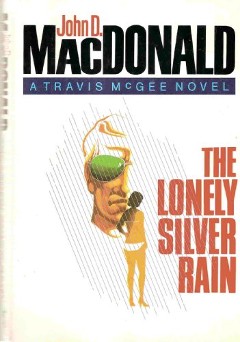Rationality, that was it. No esoteric mumbo jumbo could fool that fellow. Lord, no! His two feet were planted solidly on God's good earth.
Ellery Queen
The Lamp of God
[W]hen you have eliminated the impossible, whatever remains, however improbable, must be the truth.
Sherlock Holmes (Arthur Conan Doyle)
The Sign of the Four
Oh, oh, oh it’s magic, You know -- Never believe it’s not so!
Pilot
There's an unavoidable tension between logic and magic -- both in the real world and in fiction. In the realm of Science Fiction novels tend to fall on either side of a great divide -- fantasy (where magic reigns) and classic sci/fi, where logic and science rule. The same riven appears on the mystery side of the ledger -- magic and the inexplicable may be the rule in ghost stories and tales of the paranormal, but in the area of classic mysteries there is an unspoken compact between the author and the reader -- all must, in the end, be explained in logical terms. And for the hard-core mystery reader, the joy of the story is derived in large measure from attempting to discern the answer, the logic behind the madness, the man behind the curtain, before the author reveals not only whodunit, but how. If the room is locked, we expect to know how the crime was accomplished; if there was a dying message, well, it better be explained in the end.
Sometimes, however, there are occurrences in real life, let alone fiction, that defy logical analysis. And often that is what we brand as magic -- a conundrum that has yet to be cracked by science. So viewed, magic is a place-holder, utilized while we figure out what is actually going on. And, as Arthur C. Clarke wrote, “any sufficiently advanced technology is indistinguishable from magic.”
In one of Ellery Queen’s eeriest and most atmospheric stories, the novella The Lamp of God, a house in the forest disappears overnight. Of all of the Ellery Queen mysteries, with the possible exception of And on the Eighth Day, Lamp of God is, in my view, the strangest. The setting is other-worldly, the characters a bit surreal and the mystery itself seemingly inexplicable, Right up until the end the reader suspects that there may be something supernatural going on. But since this is an Ellery Queen story, we also know going in that a logical solution, “however improbable,” will eventually be served up.
Other writers have crafted logic-based mysteries that also deal with the inexplicable and that sometime leave those aspects of the mystery, well . . . unexplained. In Tana French’s recent novel The Secret Place, the chief mystery is logically solved, but an underlying supernatural sub theme is explored but never resolved. In Sue Gruen’s latest At the Water’s Edge, we again have a mystery that is solved but we are still left to grapple with the possibility of of a real-life Loch Ness monster. And just who, or what, is "the little stranger" in Sarah Water's book of that title?
Other writers have crafted logic-based mysteries that also deal with the inexplicable and that sometime leave those aspects of the mystery, well . . . unexplained. In Tana French’s recent novel The Secret Place, the chief mystery is logically solved, but an underlying supernatural sub theme is explored but never resolved. In Sue Gruen’s latest At the Water’s Edge, we again have a mystery that is solved but we are still left to grapple with the possibility of of a real-life Loch Ness monster. And just who, or what, is "the little stranger" in Sarah Water's book of that title?
So, what about those troubling aspects of the world that we can’t quite explain? Well, in the "real"world that’s where the argument between logic and the paranormal escalates. Take for example Extra Sensory Perception. In a “How Stuff Works” article author Tom Harris frames the ESP debate succinctly:
When all is said and done, we simply don't know whether ESP exists. Given what we do understand about the way physics operates in the universe, ESP doesn't make any sense, but this is not a valid reason to rule it out. In the history of mankind, thinkers have reevaluated their model of the universe many times in response to new evidence. The scientific process is never about deciding what can't be; it's always about figuring out what is.
 |
| Joseph Banks Rhine testing for ESP at Duke University |
But applying scientific principles and logic to determine whether ESP exists -- and how it works -- has proven to be a daunting task. Back in the 1930s a Duke University Professor, Joseph Banks Rhine, teamed with Zenith Radio Corporation in one of the earliest large scale tests of ESP ever conducted. Zenith assembled a panel of individuals who had arguably demonstrated some degree of psychic ability, and directed those "experts" to agree on a sequence of five Xs and Os that they would then collectively attempt to mentally transmit to the radio audience. The audience was then instructed to write down what they thought the sequence was and to send their answers to Zenith.
Amazingly (or so it seemed) the largest block of listener responses identified one of the precise sequences agreed upon in advance by the Zenith panel. Based upon this Zenith issued a press release trumpeting that it had proven that ESP exists since the number of correct responses was far greater than that which could be attributed to coincidence.
Amazingly (or so it seemed) the largest block of listener responses identified one of the precise sequences agreed upon in advance by the Zenith panel. Based upon this Zenith issued a press release trumpeting that it had proven that ESP exists since the number of correct responses was far greater than that which could be attributed to coincidence.
So -- it’s magic! Ahh, but not so fast. It is at this stage that the story’s detective makes his entrance. Not Sherlock Holmes, nor Ellery Queen, but instead a young psychologist named Louis Goodfellow. Not content with leaving the answer “inexplicable,” Goodfellow undertook his own study aimed at determining whether there might be a logical explanation for the results of the Zenith experiment. And, as it turned out, there was a credible scientific explanation for the those results.
The string of Xs and Os sent out “telepathically” by the Zenist panelists that was most successfully “identified” by the radio audience was “X-X-O-X-O”. But when Goodfellow tested responses from the general public he found that when asked to provide a random array of five Xs and Os over 30% responded with precisely that sequence. (Indeed, fully 78% of responses always picked “X” as the first choice in the string). So the sequence identified had nothing to do with the sequence "transmitted." From this Goodfellow surmised that the largest number of respondents picked the sequence for reasons that had nothing to do with ESP. Rather, the results simply reflect a universal inability of humans to generate truly random responses, a fact that has led to the formulation of a number of theories aimed at explaining the otherwise inexplicable. One such theory is The Law of Small Numbers, which posits that in our quest for randomness we incorrectly are driven by the supposition that small sets of numbers will be as random as larger sets. This leads us to expect an array that is shuffled.
As an example, it is a safe bet that in a test such as that administered by Louis Goodfellow virtually no one, when asked to choose a random sequence will select “O-O-O-O-O” or “X-X-X-X-X,” even though these possibilities are as randomly-likely as any others. Instead, we approach the question with pre-determined prejudices, and therefore simply find it hard to believe that such a sequence will occur randomly even though, as Goodfellow pointed out, the likelihood that five seriatim coin tosses would all be heads is only 1 in 32. In other words, statistically it would not be all that unusual, and should in fact occur roughly once every 32 times such a sequence of tosses is attempted. In short, a large number of people will always gravitate to the sequence X-X-O-X-O because that sequence “feels” random.
So logic prevailed -- the response by the audience to the Zenith experiment varied not on the ESP abilities of the listeners, nor on the psychic abilities of the panel, but rather based upon whether the specific sequence chosen by the panel matched one that most people were likely to choose as “random” on their own. And since the bias of both the panel and the recipients, all of whom were human, are shared, it is only logical that the same percentage of each group would pick sequences that feel random.
Science fiction writer William Poundstone, in his book Rock Breaks Scissors explores some of the ramifications of Goodfellow’s findings: “It basically demonstrated that a lot of the little everyday decisions we make are incredibly predictable, provided you've got a little bit of data to work from.” A real life example from Poundstone’s book -- if you are playing “Rock, Paper, Scissors,” and your opponent is a male, try choosing “paper.” Why? Well more times than not men have been shown to choose “rock.”
Magic? Nope. Just observable, predictable and documented, human behavior. According to Poundstone “it's not so easy for a person to make up a random sequence. . . . When people try to do that they fall into certain unconscious patterns, and these patterns are really very similar for everyone." Anyone who watches the pop-up ads on their laptop knows there are some sophisticated deductions being made about what each of us might be interested in purchasing. As Poundstone also observed, Goodfellow’s conclusions on predictability have “become a very big business today, needless to say.”
Magic? Nope. Just observable, predictable and documented, human behavior. According to Poundstone “it's not so easy for a person to make up a random sequence. . . . When people try to do that they fall into certain unconscious patterns, and these patterns are really very similar for everyone." Anyone who watches the pop-up ads on their laptop knows there are some sophisticated deductions being made about what each of us might be interested in purchasing. As Poundstone also observed, Goodfellow’s conclusions on predictability have “become a very big business today, needless to say.”
Here is another predictability trick, one that I first encountered 50 years ago when I was in junior high. On a piece of paper write the following: “Why did you choose carrot?” Fold the paper so that the writing cannot be seen and then hand the paper to someone, telling them not to unfold it. Then do the following:
First pause, then slowly say “Listen to me carefully, do not ask questions.” Pause again and then ask “What is 5 plus 1?” Wait for the answer. Then ask “What is 4 plus 2,” “What is 3 plus 3,” “What is 2 plus 4,” and “What is 1 plus 5.” Each time wait for the answer and then immediately proceed with the next question.
Then immediately ask your subject to say the number “6” 10 times, as rapidly as they can.
After they have said “six” for the tenth time immediately ask them to “Name any vegetable.”
Nine out of ten times your subject will say “carrot.” When (if!) they do, tell them to unfold the paper in their hand and read it.
Magic? Likely not. There is some predictable and shared mental attribute that triggers the same response in a large number of us. Okay, (the mystery reader asks) but how does it work? Apparently no one is really sure. A check on the internet reveals a lot of pondering spread over the 50 years since I first encountered this trick, but no reliable theories. It has been speculated, for example, that perhaps the answer “carrot” is prompted by the fact that the word contains six letters. But apparently the vegetable that is picked the second most is broccoli, so go figure.
Swinging back to where we started, how does all of this relate to magic versus science in mysteries? Perhaps it comes down to this: In our choice of fiction are we looking for certainty or the inexplicable? Do we read fantasy, or do we read science fiction? When we read Stephen King do we like The Stand, The Shining, or It, where the paranormal reigns, or do we like Mr. Mercedes or Finders Keepers, where none of that resides.
The Zenith ESP experiment is explainable enough that it fits into the closed world that usually comprises the mystery genre. One can picture Ellery, Sherlock or Hercule offering up the Louis Goodfellow explanation, even though that explanation also leaves some questions unanswered.
The Zenith ESP experiment is explainable enough that it fits into the closed world that usually comprises the mystery genre. One can picture Ellery, Sherlock or Hercule offering up the Louis Goodfellow explanation, even though that explanation also leaves some questions unanswered.
But I’m not sure about that carrot. I’m still sitting here, years later, waiting for a credible explanation for why that one works.
Abrakadabra!
* * * * * * * * * * *
The foregoing text was intended to be my entire article for today.
I usually avoid wading into the political arena, but after the events on Friday, played out in rainbow hues throughout Washington, D.C., I am going to succumb to temptation. Hence, this postscript.
* * * * * * * * * * *
The foregoing text was intended to be my entire article for today.
I usually avoid wading into the political arena, but after the events on Friday, played out in rainbow hues throughout Washington, D.C., I am going to succumb to temptation. Hence, this postscript.
Those keeping track of my articles over the years may have noted my penchant for beginning many with set-up quotes. (See, e.g., above!) This time I’d like to also end with two quotes.
The theme today has been the distinction between magic and reason, and the phenomenon that often that which is beyond our abilities to explain is labeled “magic” as an expedient for the fact that we can’t otherwise explain what is happening in the world around us. Sometimes things are inexplicable even when we exert diligent analytic efforts. But sometimes we just allow things to be inexplicable out of sheer laziness, or because we would rather not take the time to figure out what is really going on. So, in honor of that latter group, those who self-contentedly label something “magic” and then move on without further inquiry, I offer the following quote:
I have to admit that I’m one of those people that [sic] still thinks the dishwasher is a miracle. What a device! And I have to admit that because I think that way, I like to load it. I like to look in and see how the dishes were magically cleaned.
Thank you, Justice Clarence Thomas, for explaining so clearly the intellectually myopic wherewithal you bring to the task of analyzing the world around you. And here is the latest example of Justice Thomas' reasoning, taken from his dissent in the gay marriage case:
This is what you get when someone who thinks dishwashers are magic is given the job of determining the Constitutional protections that are to be accorded to all others. I am always heartened when the views of Justice Thomas (or Scalia or Alito, for that matter) concerning the reach of the Constitution are consigned to dissenting opinions.
[H]uman dignity cannot be taken away by the government. Slaves did not lose their dignity (any more than they lost their humanity) because the government allowed them to be enslaved. Those held in internment camps did not lose their dignity because the government confined them. And those denied governmental benefits certainly do not lose their dignity because the government denies them those benefits. The government cannot bestow dignity, and it cannot take it away.What????
This is what you get when someone who thinks dishwashers are magic is given the job of determining the Constitutional protections that are to be accorded to all others. I am always heartened when the views of Justice Thomas (or Scalia or Alito, for that matter) concerning the reach of the Constitution are consigned to dissenting opinions.
 |
| Colin Black Andrews and Kyle Hartwig At the White House -- June 26, 2015 |
























